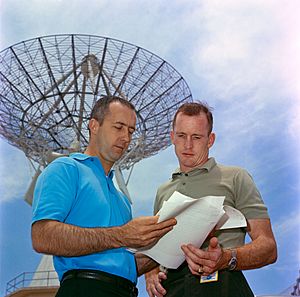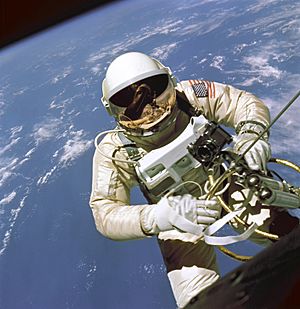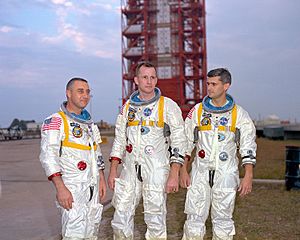Ed White (astronaut) facts for kids
Quick facts for kids
Ed White
|
|
|---|---|

White in 1966
|
|
| Born |
Edward Higgins White II
November 14, 1930 San Antonio, Texas, U.S.
|
| Died | January 27, 1967 (aged 36) Cape Kennedy, Florida, U.S.
|
| Resting place | West Point Cemetery |
| Other names | Ed White |
| Alma mater | |
| Occupation |
|
| Awards |
|
| Space career | |
| NASA astronaut | |
| Rank | Lieutenant colonel, United States Air Force |
|
Time in space
|
4d 01h 56m |
| Selection | 1962 NASA Group 2 |
|
Total EVAs
|
1 |
|
Total EVA time
|
36 minutes |
| Missions | Gemini 4, Apollo 1 |
|
Mission insignia
|
|
Edward Higgins White II (born November 14, 1930 – died January 27, 1967) was an American engineer, United States Air Force officer, test pilot, and NASA astronaut. He is famous for being the first American to walk in space. He was part of the crews for the Gemini 4 and Apollo 1 missions.
After finishing his degree at West Point in 1952, White became a pilot. He flew fighter jets like the F-86 Sabre and North American F-100 Super Sabre in West Germany. In 1958, he went back to school at the University of Michigan to study aeronautical engineering. He earned his master's degree in 1959. White then trained as a test pilot at Edwards Air Force Base in California.
White was chosen by NASA in 1962 as one of the "Next Nine" astronauts. These astronauts were picked for the Gemini and Apollo missions. He was the pilot for Gemini 4 with James McDivitt as the commander. On June 3, 1965, White made history by becoming the first American to walk in space. Later, he was assigned to the first crewed Apollo mission, Apollo 1. Sadly, Edward White died on January 27, 1967. He was with fellow astronauts Virgil "Gus" Grissom and Roger B. Chaffee when a fire broke out during a test for Apollo 1. This happened at Cape Canaveral, Florida. White received the NASA Distinguished Service Medal for his spacewalk. He was also given the Congressional Space Medal of Honor after his death.
Contents
Early Life and Military Path
Edward Higgins White II was born in San Antonio, Texas, on November 14, 1930. His father, Edward Higgins White Sr., was a West Point graduate and later became a major general in the United States Air Force (USAF). Edward's interest in aviation started when he was twelve. His father took him for a ride in a trainer plane. He was also a Boy Scout.
Because of his father's military job, White's family moved often. He went to schools in Ohio and Washington, D.C. After high school in 1948, he wanted to go to West Point, just like his father. It was hard to get in because his family moved so much. But he worked hard and got an appointment from a Congressman.
White started at West Point on July 15, 1948. He was nicknamed "Red" because of his hair color. He was a good athlete, competing in hurdles and playing soccer. His hobbies included squash, handball, swimming, golf, and photography. One of his classmates was Michael Collins, who also became an astronaut.
Becoming an Air Force Pilot
After graduating from West Point in 1952, White became a second lieutenant in the Air Force. He received his first pilot training in Florida and jet training in Texas. In 1953, he earned his pilot wings. He then went to Fighter Gunnery School in Arizona. In February 1953, White married Patricia Eileen Finegan. They had two children, Edward Higgins White III and Bonnie Lynn White.
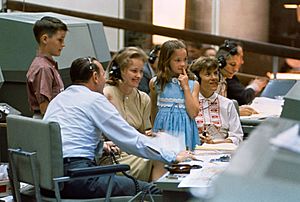
White spent three and a half years flying F-86 Sabre and North American F-100 Super Sabre jets in West Germany. One of his colleagues there was Buzz Aldrin, who also became an astronaut. In 1957, White read about future astronauts and decided he wanted to be one. He thought getting an advanced degree would help. In September 1958, he began studying aeronautical engineering at the University of Michigan. He earned his master's degree in 1959.
White then realized that being a test pilot would also boost his chances of becoming an astronaut. He attended the U.S. Air Force Test Pilot School in California, graduating in July 1959. He then worked at Wright-Patterson Air Force Base in Ohio. There, he tested weapons and helped design aircraft. He also piloted planes used to train astronauts in weightlessness. Among his passengers were John Glenn, the first American to orbit Earth, and Ham, the first chimpanzee in space. White flew over 3,000 hours in his Air Force career.
NASA Career and Historic Spacewalk
Joining the Astronaut Team
In 1962, the Air Force suggested White as a possible candidate for NASA's second group of astronauts. He was one of 32 finalists who went through tough medical and psychological tests. White was chosen as one of nine new astronauts in September 1962. Like the first group, each new astronaut was given a special area to focus on. White's area was flight control systems.
Gemini 4 Mission and Spacewalk
White was chosen as the pilot for Gemini 4, with McDivitt as the commander. They were paired because they knew each other well from school. The mission had several goals, including a possible extravehicular activity (EVA), also known as a "spacewalk."
McDivitt pushed for the spacewalk to be included. NASA agreed to make sure White's Gemini space suit could be used for an EVA. On March 18, 1965, Soviet cosmonaut Alexei Leonov became the first person to perform an EVA. After this, NASA officially approved the spacewalk for Gemini 4 on May 25.
White was a religious person. For his spacewalk, he carried three small religious items: a gold cross, a St. Christopher Medal, and a Star of David. He said he wanted to take items that were meaningful to him.
On June 3, 1965, the Gemini 4 crew launched into space for their four-day mission. After separating from the rocket, McDivitt tried to fly close to the booster, but it didn't work. The astronauts weren't fully trained for this kind of maneuver in space. The mission also included 11 science experiments.
White's spacewalk was planned for the third time around Earth. At 7:46 PM UTC, White became the first American to perform an EVA. During his spacewalk, he used a special oxygen-powered gun to move around. White loved the experience so much that he didn't want to come back inside the spacecraft. He had to be told to return.
While White was outside, one of his spare gloves floated away. It became an early piece of space debris. There was also a problem with the spacecraft's hatch. It was hard to open and close. McDivitt had to push on the gears to get it locked. If the hatch hadn't locked, they couldn't have safely returned to Earth.
When they came back, White and McDivitt were heroes. President Lyndon B. Johnson congratulated them and promoted them to lieutenant colonel. They received the NASA Exceptional Service Medal and had a parade in Chicago. They even met Soviet cosmonaut Yuri Gagarin in Paris.
After Gemini 4, White was assigned as the backup for the Gemini 7 mission. He was also the expert on the flight control systems for the Apollo command module.
Apollo 1 Tragedy
In March 1966, White was chosen for the first crewed Apollo flight, called AS-204. He was the senior pilot. His crewmates were Commander Virgil "Gus" Grissom and Pilot Roger Chaffee. The mission was named Apollo 1 in June. It was supposed to launch in early 1967.
The launch of Apollo 1 was set for February 21, 1967. On January 27, the crew entered the spacecraft for a "plugs-out" test. This test was to check all the systems and procedures. The rocket was not fueled, so it was not considered dangerous. However, there were delays due to a strange smell in the cabin and poor communication. At 6:31 PM, a fire suddenly started inside the cabin, which was filled with pure oxygen. All three astronauts died.
During an emergency, White was supposed to open the inner hatch. His body was found in his seat, reaching for the hatch. But the hatch design made it impossible to open quickly from the inside. The intense heat made the cabin pressure rise, causing the walls to break. The astronauts died from asphyxiation, smoke inhalation, and thermal burns.
After the Fire
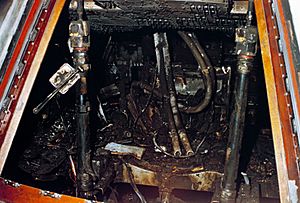
Investigators found that the fire started from a spark from a wire under Grissom's seat. The deaths were caused by several dangerous issues in the Apollo Command Module. These included the 100% oxygen atmosphere, faulty wiring, flammable materials, and a hatch that couldn't be opened fast enough. After the accident, these problems were fixed. The Apollo program then continued successfully, eventually landing humans on the Moon.
Edward White was buried with full military honors at West Point Cemetery. His younger brother, James, wanted to follow in his footsteps. James became a fighter pilot and volunteered for the Vietnam War. Sadly, he was killed in a plane crash on November 24, 1969. His remains were identified much later and buried next to Edward's in 2018.
Awards and Memorials
White received many awards and honors for his service and achievements. These include the Senior Astronaut Wings, the Air Force Commendation Medal, and the Golden Plate Award. He also received honorary degrees and the John F. Kennedy Trophy with McDivitt. The Apollo 1 crew was given the NASA Distinguished Service Medal after their deaths. In 1997, President Clinton presented White's family with the Congressional Space Medal of Honor.
White was inducted into the International Space Hall of Fame in 1982. He was also inducted into the U.S. Astronaut Hall of Fame in 1993 and the National Aviation Hall of Fame in 2009.
Places Named After White
Many schools and places have been named in honor of Edward White:
- Edward White Elementary Career Academy in Chicago
- Edward H. White Middle School in White's hometown of San Antonio, Texas
- Edward H. White II Elementary School in El Lago, Texas
- Edward White Elementary School in Eldridge, Iowa
- Ed White Memorial High School in League City, Texas
- Edward H. White High School in Jacksonville, Florida
- Edward H. White Elementary School in Houston, Texas.
- Ed White Middle School in Huntsville, Alabama.
- Edward H. White Memorial Youth Center, Seabrook, Texas
In Space and on Stamps
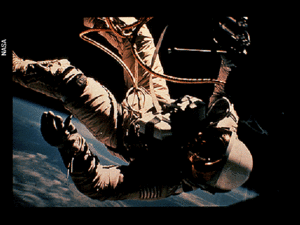
- A star called Iota Ursae Majoris was nicknamed "Dnoces." This is "Second" spelled backwards, referring to "Edward Higgins White the Second."
- White Hill on Mars is named after him. It is part of the Apollo 1 Hills.
- A picture of White during his Gemini 4 spacewalk is on the Voyager Golden Record. This record was sent into space on the Voyager spacecraft for any intelligent life to find.
- Eight months after his death, in September 1967, the U.S. Post Office released a postage stamp honoring White's spacewalk. It was special because the design was spread across two stamps. One showed White, and the other showed his Gemini capsule, connected by a tether.
Omega Speedmaster "Ed White"
The Omega Speedmaster wristwatch, model 105.003, is known as the "Ed White." This is because White wore this watch during his spacewalk. The Speedmaster is still the only watch approved by NASA for spacewalks.
In Media
Edward White has been shown in several films and TV series:
- Steven Ruge played him in the 1995 film Apollo 13.
- Chris Isaak played him in the 1998 HBO miniseries From the Earth to the Moon.
- Matt Lanter played him in the 2015 ABC TV series The Astronaut Wives Club.
- In 2018, he was played by Jason Clarke in First Man.
Images for kids
-
One of two Apollo 1 memorial plaques at Cape Canaveral Air Force Station Launch Complex 34
-
Ed White III touches his father's name engraved in the Space Mirror Memorial at the KSC Visitor Complex.
See also
 In Spanish: Edward Higgins White II para niños
In Spanish: Edward Higgins White II para niños
- Fallen Astronaut
- List of spaceflight-related accidents and incidents


